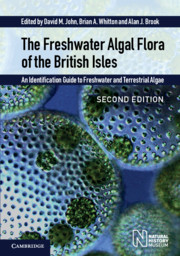 The Freshwater Algal Flora of the British Isles
The Freshwater Algal Flora of the British Isles Book contents
- Frontmatter
- Contents
- The online material (formerly provided in DVD format)
- List of Contributors
- Foreword
- Preface
- Acknowledgements
- Introduction
- Distribution and Ecology
- History of Freshwater Algal Studies in the British Isles
- Field Methods
- Laboratory Methods
- Water Framework Directive
- Cultures of British Freshwater Algae
- Classification
- Key to phyla
- Cyanobacteria (Cyanophyta)
- Phylum Rhodophyta (Red Algae)
- Phylum Euglenophyta (Euglenoids)
- Phylum Cryptophyta (Cryptomonads)
- Phylum Dinophyta (Dinoflagellates)
- Phylum Raphidophyta
- Phylum Haptophyta (Prymnesiophyta)
- Phylum Chrysophyta (Golden Algae)
- Phylum Xanthophyta (Tribophyta) (Yellow-Green Algae)
- Phylum Eustigmatophyta
- Phylum Bacillariophyta (Diatoms)
- Phylum Phaeophyta (Brown Algae)
- Primitive Green Algae (‘PRASINOPHYTA’)
- Phylum Chlorophyta (Green Algae)
- Phylum Glaucophyta
- Glossary
- Standard Form of Authors of Algal Names
- Sources of Illustrations or Material
- References
- Taxonomic Index
- Subject Index
- Plate Saction
- Miscellaneous Endmatter
- Miscellaneous Endmatter
Phylum Rhodophyta (Red Algae)
Published online by Cambridge University Press: 12 January 2024
- Frontmatter
- Contents
- The online material (formerly provided in DVD format)
- List of Contributors
- Foreword
- Preface
- Acknowledgements
- Introduction
- Distribution and Ecology
- History of Freshwater Algal Studies in the British Isles
- Field Methods
- Laboratory Methods
- Water Framework Directive
- Cultures of British Freshwater Algae
- Classification
- Key to phyla
- Cyanobacteria (Cyanophyta)
- Phylum Rhodophyta (Red Algae)
- Phylum Euglenophyta (Euglenoids)
- Phylum Cryptophyta (Cryptomonads)
- Phylum Dinophyta (Dinoflagellates)
- Phylum Raphidophyta
- Phylum Haptophyta (Prymnesiophyta)
- Phylum Chrysophyta (Golden Algae)
- Phylum Xanthophyta (Tribophyta) (Yellow-Green Algae)
- Phylum Eustigmatophyta
- Phylum Bacillariophyta (Diatoms)
- Phylum Phaeophyta (Brown Algae)
- Primitive Green Algae (‘PRASINOPHYTA’)
- Phylum Chlorophyta (Green Algae)
- Phylum Glaucophyta
- Glossary
- Standard Form of Authors of Algal Names
- Sources of Illustrations or Material
- References
- Taxonomic Index
- Subject Index
- Plate Saction
- Miscellaneous Endmatter
- Miscellaneous Endmatter
Summary
Introduction
The red algae constitute a division (phylum) of organisms that share the following combination of attributes: eukaryotic cells, lack of flagella, floridean starch, phycobiliprotein pigments, unstacked thylakoids, and chloroplasts lacking an external endoplasmic reticulum (Woelkerling, 1990). They are primarily marine, with only approximately 3% of the over 6102 species in truly freshwater habitats (Sheath, 1984; Guiry and Guiry, 2010). Most of the inland red algae are restricted to streams and rivers (Sheath and Hambrook, 1990). A small number occur in habitats other than typical freshwaters, such as soils (Geitler, 1932b) and caves (Hoffmann, 1989). There are monographic- type publications on freshwater red algae from continental Europe worth consulting, including Israelson (1942) –, Eloranta and Kwandrans (2007) and Eloranta et al. (2011). Kumano (2002) provides a comprehensive compilation of taxonomic studies worldwide.
Vegetative Morphology
Most of the red algae in freshwater habitats tend to be macroscopic and benthic (Sheath andHambrook, 1990). Nonetheless, these algae exhibit a smaller size range than do marine species, with 80% of freshwater red algae having a length range of 1–10 cm (the same percentage of marine species ranges up to 30 cm). There are 22 species recorded from the British Isles that are currently accepted, of which 9 are gelatinous filaments (Batrachospermum, Pl. 40A; Sirodotia, Pl. 41F; Thorea, Pl. 43F), 3 are free filaments without a prominent gelatinous matrix (Compsopogon, Pl. 39F; Bangia, Pl. 35B– D; Balbiania, Pl. 36D–F), 3 are pseudoparenchymatous forms (Lemanea, Pls. 42C–E, 43A,B; Paralemanea, Pl. 43C–E), 2 are tufts of short radiating filaments without a common matrix (Audouinella, Pl. 35E,F; 36A–C), 2 are unicells (Porphyridium, Pl. 34D,E), and there is one each of a pseudofilament consisting of loose chains of cells held together with a common gelatinous matrix (Chroodactylon, Pl. 34A,B), a colony with stalked unicells (Chroothece, Pl. 34C), and a crust of a flat thallus composed of compacted tiers of cells (Hildenbrandia, Pl. 44B,C). Among the filamentous forms only Thorea has multiaxial growth (Pl. 44A); the rest are uniaxial, except Bangia, which has a uniaxial base and multiaxial apex at maturity (Pl. 35B,C). Compsopogon has uniaxial filaments that are covered by a layer of small cortical cells (Pl. 35A).
The various morphological forms encounter the stress caused by flow in riverine habitats in different ways, according to Sheath and Hambrook (1988, 1990). Crusts and short tufts occur within the boundary layer or at least in a region of reduced current velocity and hence avoid much of the flow-related stress.
- Type
- Chapter
- Information
- The Freshwater Algal Flora of the British IslesAn Identification Guide to Freshwater and Terrestrial Algae, pp. 159 - 180Publisher: Cambridge University PressPrint publication year: 2021
